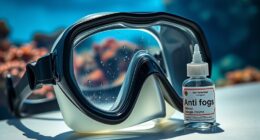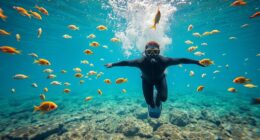When it comes to full-face versus traditional snorkel masks, you’ll find pros and cons to both. Full-face masks offer easy breathing through your nose and mouth, enhancing comfort, especially for beginners. However, they can feel bulkier and may restrict vision. On the other hand, traditional masks provide a customizable fit and a wider field of view, but you breathe solely through a snorkel, which might feel less natural for some. Discover more insights to help you choose the best option for your needs.
Key Takeaways
- Full-face masks offer easy breathing through both nose and mouth, enhancing comfort for beginners, while traditional masks require snorkel use.
- Traditional masks provide a more customizable fit, reducing the risk of leaks compared to full-face masks.
- Full-face masks can be bulkier, potentially affecting buoyancy and maneuverability; traditional masks are generally sleeker and allow for better movement.
- Visibility is often better with traditional masks, which typically provide a wider field of view than full-face options.
- User preference plays a significant role, with some prioritizing comfort and ease in full-face masks, while others prefer the secure fit of traditional masks.

Have you ever wondered which type of snorkel mask is right for you: a full-face mask or a traditional one? Choosing between these two options can substantially affect your underwater experience. Full-face masks cover your entire face, allowing you to breathe through your nose and mouth, while traditional masks typically cover just your eyes and nose, requiring you to breathe through a snorkel. The decision often boils down to mask fit and breathing ease, so let’s break down the pros and cons of each.
When it comes to mask fit, a traditional snorkel mask usually offers a more customizable experience. You can adjust the straps to guarantee a snug fit, which can prevent water from leaking in during your adventure. A well-fitted traditional mask allows you to focus more on the underwater sights rather than worrying about your gear. On the other hand, full-face masks come in various sizes and designs, but finding the perfect fit might be trickier. If the mask doesn’t seal properly, it could leak, which can be frustrating when you’re trying to enjoy your time beneath the waves.
Breathing ease is another critical factor to contemplate. Full-face masks are often praised for their comfort, as they let you breathe through both your nose and mouth. This can make for a more relaxed snorkeling experience, especially for beginners who might feel anxious about breathing through a snorkel. However, some snorkelers find that traditional masks provide a more natural feeling when breathing through the snorkel. It can be easier to control your breathing and maintain a relaxed pace, which is essential for a long day of snorkeling.
That said, full-face masks can be more cumbersome and might restrict your vision, depending on the model. They tend to have a larger profile, which may affect your buoyancy and maneuverability in the water. Traditional masks, while less accommodating for breathing, often provide a wider field of view and a sleeker design. Creating the perfect ambiance for your snorkeling experience can also enhance your enjoyment of the underwater world.
Ultimately, the choice between a full-face mask and a traditional snorkel mask comes down to personal preference. If you prioritize breathing ease and comfort, a full-face mask may be the way to go. However, if you value a secure mask fit and a more traditional experience, a traditional snorkel mask could be your best bet. Whichever you choose, make sure it fits well and allows you to enjoy the beauty of the underwater world.
Frequently Asked Questions
Are Full-Face Snorkel Masks Suitable for Children?
Yes, full-face snorkel masks can be suitable for children, but you need to take into account age appropriateness. Make sure the mask fits snugly to avoid leaks and ensure your child’s safety while swimming. Always supervise them in the water, as full-face masks can limit their ability to communicate or signal distress. Check for manufacturer guidelines that specify age recommendations before purchasing. Prioritizing children’s safety will help make their snorkeling experience enjoyable and worry-free.
Can I Wear Glasses With a Full-Face Snorkel Mask?
Can you really enjoy snorkeling if you can’t see clearly? Unfortunately, wearing glasses with a full-face snorkel mask isn’t ideal, as most designs aren’t compatible with eyewear. However, you can explore vision correction options, like prescription lenses that fit inside the mask or contact lenses. These alternatives guarantee you maintain clear vision while enjoying your underwater adventures. Just make sure to check the mask’s specifications for the best fit and comfort!
How Do I Clean My Snorkel Mask Properly?
To clean your snorkel mask properly, start with rinsing it in fresh water to remove salt and debris. Use a soft cloth and mild soap for deeper cleanings, avoiding harsh chemicals that could damage the lens. For mask maintenance, consider applying a defogging solution before each use; this prevents fogging during your dive. Always store your mask in a cool, dry place to extend its lifespan and keep it in top condition.
What Is the Lifespan of a Traditional Snorkel Mask?
A traditional snorkel mask can last anywhere from 2 to 5 years, depending on how well you take care of it. Think of it like a favorite pair of shoes; the more you wear them without proper care, the quicker they wear out. Mask durability hinges on its material longevity, so store it away from sunlight and clean it gently after each use. Treat it right, and you’ll enjoy many adventures together!
Are Full-Face Masks More Prone to Fogging Than Traditional Masks?
Yes, full-face masks can be more prone to fogging issues than traditional masks. This happens mainly due to their design and mask ventilation. If the ventilation isn’t efficient, moisture can build up inside, causing fog. To minimize this, you should guarantee a proper fit and clean the lens beforehand. You might also consider anti-fog sprays or solutions specifically designed for snorkeling gear to enhance your experience and visibility underwater.
Conclusion
In the end, choosing between a full-face and traditional snorkel mask is like picking between a vibrant canvas and a classic sketch. Each offers its own unique experience beneath the waves. If you crave the freedom of panoramic views and ease, the full-face mask might be your masterpiece. But if you prefer the intimacy of tradition and simplicity, the traditional mask could be your timeless treasure. Plunge in, explore, and find the mask that paints your underwater adventure.










